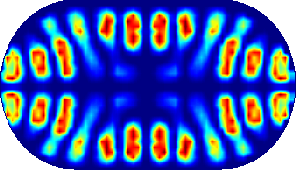Quantum Chaos

certaintiesand quantum mechanical probabilities have to match with one another (correspondence principle). How does this work for systems which classically show a complex yet well-organized behaviour - in short: chaotic dynamics? Classical chaos forms infinitely fine structures, but quantum mechanics sets up fundamental limits for this.
The feature of deterministic chaos of classical systems is known only in rudimentary form at the times when the quantum theory develops. It takes decades to detect chaotic dynamics almost everywhere and to understand that classical mechanics, with their focus on regular motions, are concerned with exceptional cases in fact. Is here a deeper reason for their failure in the atomic range?
As far as the modern quantum theory is wave mechanics, there are classical systems which allow sound conclusions in analogy. The figure shows a "whispering gallery" of microwaves inside stadium-like bounds. The puzzling question now: Does the quantum world not bear at all a generalization of classical chaos? The stadium billard
, which is chaotic in the particle picture, shows regular structures in the wave picture. Are there nevertheless finger prints
in quantum systems which allow to recognize whether or not they are chaotic in the classical limit - and what would this mean?
 Scene
Scene


 1st Slide
1st Slide
 Branching Point
Branching Point
 Module: Mikrowelt: Bose-Einstein-Kondensat/Photonenstatistik
Module: Mikrowelt: Bose-Einstein-Kondensat/Photonenstatistik Sequence: lev0_start
Sequence: lev0_start Branching Point: Particles and Light under Control
Branching Point: Particles and Light under Control Slide: Functional Principle of the Paul Trap
Slide: Functional Principle of the Paul Trap

 History
History